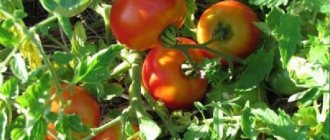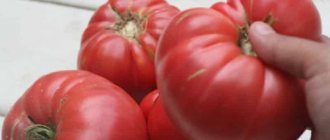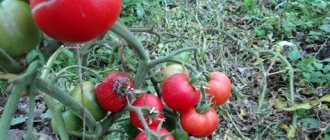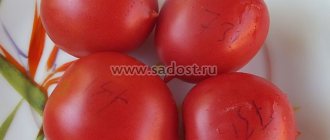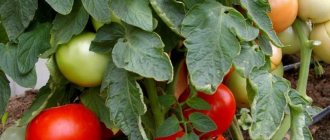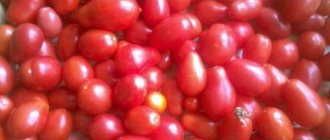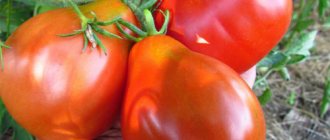Varietal tomato, originator - agro, registered in the State Register in 2004. Recommended for growing in open ground and in film shelters. Flash tomatoes are intended for commercial production, cultivation in private farms, the purpose of the variety is salad.
| Height | Landing location | Ripening time | Fruit color | Fruit size | Origin | Fruit shape |
| short | Open ground | Ultra early | Reds | Average | Variety | Round |
Description and characteristics of the variety
The outbreak belongs to the determinant group, the bushes are small, stocky, grow up to 40-50 cm. The tomato is ultra-early, 95-100 days pass from germination to the first fruits. The leaf blades are medium sized, dense, dark green in color. Plants are heavily leafy. The inflorescences are simple, the first appears above the 5-6th leaf, the subsequent ones are laid through the leaf or immediately after each other.
The lifespan of tomatoes is short. The plant is completed after 4-5 brushes; after harvesting, the bushes are removed from the garden bed.
The tomatoes are medium-sized, smooth, round, covered with thin red skin. The ribbing in the upper part of the fruit is weakly expressed. The pulp is 5-6 chambered, tender, with an average amount of seeds and liquid. The tomatoes are juicy, sweet, with a pleasant sourness.
Rules of agricultural technology
The Flash variety is considered one of the most unpretentious tomatoes that can be grown even in the northern part of the country. Low bushes rarely get sick and tolerate many weather troubles well. But if the weather is expected to be rainy and cool in the summer, it is worth planting the bushes in a permanent place in the greenhouse. Here, the timing of fruit ripening may be slightly shifted upward, but this way the crop is guaranteed to survive even during summer cold snaps.
This variety, like other varieties of tomatoes, grows well if it is fed. In addition, it is very important for a tomato to saturate the roots with oxygen, which can be achieved by simply loosening the soil. If you approach agricultural technology issues correctly, you can get a large number of tomatoes from each bush. The better the plant care, the larger the tomatoes will be.
See also
Description of the striped pepper tomato Sherkhan and cultivation techniques
Read
Advantages and disadvantages
Pros:
- Adapts to weather changes, tolerates mild cold snaps without shedding the ovary.
- The bushes are compact and suitable for growing in small areas.
- Low growing, require minimal attention.
- The fruits have an attractive presentation.
- The plant is resistant to fungal diseases and is rarely affected by pests.
- Ripe fruits are tender and tasty. Suitable for fresh consumption, salads, and preparations.
Minuses:
- Unsuitable for whole-fruit canning; the tomato skin is thin and the flesh is not dense enough.
- Compared to tall tomatoes, the yield is average.
Pickling tomatoes from Sedek, video
If you grew Flash tomatoes, please write what was the yield and taste of the fruit in your climatic conditions? How do you rate the disease resistance of this variety? If possible, attach to your review a photo of the entire bush or individual tomatoes you grew.
You can see other interesting varieties and hybrids of tomatoes with photos, descriptions and reviews in our Tomato Catalog. Enjoy watching.
Your feedback on the Vsplyshka tomato, as well as additions to the description, will help many gardeners evaluate this variety objectively and decide whether it is worth planting or not.
Features of cultivation and storage
Tomato seedlings grow quickly, so a bush sown too early will stretch out, take root less well in the garden, and become more susceptible to disease. Tomatoes are grown in seedlings and without seedlings. The bushes do not need to be formed or pinched, but they do need to be tied up.
The more sunlight the plants receive, the sweeter and richer the taste of ripe tomatoes.
Tomatoes can be stored and transported in a state of technical ripeness. But ripe fruits are not stale. If the standards are observed, the shelf life without loss of commercial quality is no more than 2-3 weeks.
Reviews
Catherine:
“The Flash variety is one of the best among all the tomatoes available today. Tomatoes show resistance to various unfavorable conditions, cold weather, parasites and diseases. Despite this resistance to testing, proper agricultural practices play a truly important role. I’ve gotten used to growing the Vspishka variety and now I’m getting a rich early harvest.”
Margarita:
“I really love growing different varieties of tomatoes and, of course, comparing them. At the same time, I choose tomato varieties that can be grown easily and quickly with a guaranteed rich and good harvest. So, Flash tomatoes are becoming increasingly popular. At the same time, the ease and convenience of agricultural technology allows you to obtain an impeccable and very nutritious harvest. I am always satisfied with the harvest!”
Care instructions
The versatility of Flash tomatoes provides the possibility of growing them both in the form of seedlings and by sowing in the ground using temporary dense film cover. If cultivation begins with the receipt of strong seedlings, then sowing of seeds must be carried out one and a half to two months before the planned planting of seedlings. For example, seedlings that are at least 50-55 days old can be placed in open ground.
It may take about 5–7 days for the first shoots to appear, and a week before planting, the sprouts must be hardened by taking them out into the open air for several hours. All sowing work is carried out at the end of March or early April.
It is best to transplant to permanent soil in the third ten days of May, when the risk of return of night frosts is minimal. The distance between the bushes should be at least 40 - 60 cm. Fertilizing is carried out once every 3 - 4 weeks using mineral complexes.
Tags: flash, description, variety, tomato, characteristics
About the author: admin4ik
« Previous entry
Tomato Flash - an early star on the dacha horizon
It is natural to expect a fullness of taste from medium or late tomatoes, but the combination of pleasant sweetness and meatiness in early varieties creates a feeling of unexpected joy. The Flash tomato illuminates with the brightness of its colors, surprises with the juiciness and sugar content of the fruit pulp, and fills you with pride for the harvest.
Description of the standard tomato variety Flash
Since 2004, the Flash tomato has been included in the State Register for all regions of the Russian Federation for cultivation in open ground. This is an early-ripening, standard tomato with a determinant growth pattern. Plant height 40–50 cm. Leaves are dark green, medium in size. The inflorescence is complex, the first raceme is formed above 5–6 leaves, the rest may not be separated by leaves.
The fruits are small, round, slightly ribbed. Unripe fruits are light green, ripe tomatoes are deep red. The skin is thin, but the fruits are resistant to cracking. The pulp on the break is sugary. There are 4 or more seed chambers. The weight of the fruit usually does not exceed 80–100 g.
The bush is low, standard. Unripe fruits are light green and good for pickling.
The taste of fresh tomatoes is excellent. They are used in salads and processed products are prepared: juice, puree, lecho, adjika. The small size of the fruit allows them to be used for canning in their own juice. Unripe tomatoes go into pickling.
The yield of the variety is 4.8 kg/m2. The yield of commercial products reaches 99%. This tomato is resistant to adverse weather conditions and watering problems. Thanks to very early ripening, the fruits have time to “escape” late blight. According to reviews from summer residents, even if the leaves caught the fungus, the tomatoes ripened without damage.
Advantages and disadvantages of tomato Flash
Among the obvious advantages of this variety:
- Unpretentiousness in cultivation: the bushes do not need shaping or pinching.
- Very early fruit ripening.
- Unexpectedly pleasant taste for early ripening tomatoes.
- The versatility of fruit use.
- Resistant to extreme growing conditions.
- Almost 100% yield.
- Relative insensitivity of bushes to late blight.
Some summer residents note that in favorable conditions, a crop is also formed on the stepchildren.
These tomatoes are delicious fresh and easy to process.
The variety has no obvious disadvantages, but the following can be noted:
- Thin skin of the fruit, which makes transportation and storage of tomatoes difficult.
- Relatively low yield.
Of course, compared to greenhouse growing, indeterminate varieties, the Vspishka tomato loses in productivity, but it does not require the cost of arranging this very greenhouse, and the taste is in no way inferior to varieties of protected soil.
The thin skin of the fruit is not a flaw, but a feature. It is pleasant when you cut early tomatoes into a salad or stew them with cheese and basil. But the difficulty in transportation is annoying, because I want to share the joy of the first tomatoes. This skin does not need to be removed, since directly underneath it contains a lot of useful things. I scroll through the ripe tomatoes whole, removing only the green bottom. To the resulting mass I add finely chopped garlic, cilantro, some ground fenugreek seeds, red hot pepper and salt to taste. Fresh spicy sauce is ready. It is suitable for meat and fish dishes, and also goes well with pasta and potatoes in any form. You don't need to cook a lot of sauce to prevent it from turning sour.
Fresh tomato sauce enriches the taste of meat and fish dishes, saturating them with vitamins
Features of cultivation
All gardeners with experience in growing this variety are unanimous that there is no need to rush with sowing so that the seedlings do not stretch out. Sowing of seeds for seedlings begins no earlier than 50–55 days before the expected date of planting in the ground. To prevent plants from suffering from picking, only 1-2 seeds are planted in seedling cups. Further care is no different.
It is necessary to monitor the illumination of the seedlings so that the tender seedlings do not stretch out. If necessary, the cassettes are illuminated with phytolamps.
Two weeks before the expected planting date, the seedlings begin to harden. This is necessary to adapt the plants to external environmental conditions. In the phase of 5–6 true leaves, tomatoes are planted in open ground. No more than 4–5 bushes are placed per 1 m2 according to the 40x60 pattern.
It has been noticed: the further south the Flash tomato is cultivated, the richer and sweeter the taste of its fruits.
For planting, choose an unshaded space, placing the bushes from north to south so that the plants are illuminated by the sun throughout the summer day and are well ventilated.
Planting care includes:
- Loosening the rows, which suppresses the growth of weeds and saturates the soil with oxygen.
- Mulching the tree trunk area with freshly cut grass. This keeps the soil ball loose, preventing it from drying out. When plant residues decompose, organic matter, moisture and heat are released, which has a positive effect on the development of tomatoes.
- Weed control.
- Timely watering, although the Flash tomato tolerates short-term drought without damage.
- Periodic feeding.
Typically, plants are given 2-3 feedings during the growing season. These can be mineral fertilizers, mainly potassium (potassium sulfate) and phosphorus (simple or double superphosphate), as well as complex balanced fertilizers for tomatoes, used strictly according to the instructions. Giving nitrogen fertilizers, as well as adding excess manure to the soil, is not recommended, as this provokes the spread of late blight. In addition, excess nitrogen leads to preferential growth of greenery to the detriment of fruit formation, and the bushes begin to “fatten”.
To avoid this, but provide tomatoes with organic fertilizers, some gardeners successfully use crop rotation. They build a “warm bed”; in the first year, fertilizer-hungry cucumbers and zucchini are planted, and the next season, tomatoes are safely planted in the same bed.
Experienced summer residents apply ash as potash fertilizer, adding it to the planting hole at the rate of 100–150 ml per bush. By updating the layer of plant mulch 2–3 times per season, the remaining compounds are supplied. Spraying with solutions has a positive effect on tomatoes: iodine (6–7 drops per 10 liters of water), potassium permanganate (light pink fresh solution), baking soda (2 tablespoons per 10 liters of water). The first spraying with iodine begins two weeks after planting the tomato. 7–8 days after it, a solution of potassium permanganate is used, after the same period of time, sprayed with soda. Repeat 2-3 times per season, watering all the tomato bushes. Such treatments stimulate plant immunity, supply nutrition in the form of foliar fertilizers and prevent the development of late blight, which is not important for the Vspashka variety.
Watering is carried out in the morning or evening, avoiding water getting on the leaves. Watering frequency: once every five days. As the fruits begin to ripen, reduce watering, allowing the tomatoes to ripen and gain flavor.
The Flash tomato grows and bears fruit without any hassle for both experienced gardeners and neophyte gardeners. This is a good variety for opening the harvest season.
Reviews of tomato Flash
I planted the flash. The main thing is not to rush to plant seedlings, they grow very quickly, otherwise they will outgrow and take root worse. This is generally an early ripening variety. showed excellent performance in open ground. Of course, the yield cannot be compared with two-meter greenhouse ones, but there is practically no maintenance. a low bush, some even did without a garter. It doesn’t bother me with my stepchildren. I really liked the tomatoes: medium-sized, not small, just right for pickling, but I didn’t get to the point of pickling - they were sweet, we ate them all like that, mostly right at the dacha and enjoyed them. Yes, the skin is thin. but on the contrary, I don’t like thick-skinned ones, I’m tired of store-bought ones. They began to bear fruit early and it took a long time for new ones to appear. This year I will plant for sure.
yuliyazaitseva
https://otvet.mail.ru/question/174956641
Last season I really liked the variety “Pygmy”: small, slightly sour, they began to bear fruit in early June and until winter. ... I also planted “Flash” and “Explosion”, which are also good.
priv_oksana
https://www.e1.ru/talk/forum/read.php?f=122&i=170321&t=170321&
Outbreak Sowed in February for an early harvest. The first ones were filmed on 07/02/12. They grew up in a greenhouse. I thought they would give away the first harvest together and I would free up space in the greenhouse so that the Indians would not get in the way. But that was not the case, the Flash bore fruit tirelessly until frost. In the summer it was finished, but it produced stepsons and continued to bear fruit on them. ... I'm happy with it. The tomatoes turned out to be early, not small, of very good taste for early ones, not sour or watery, but on the contrary, sugary at break and sweetish. The height in the greenhouse was about 50 cm, the bush was quite wide.
Cherry. Baranovichi
